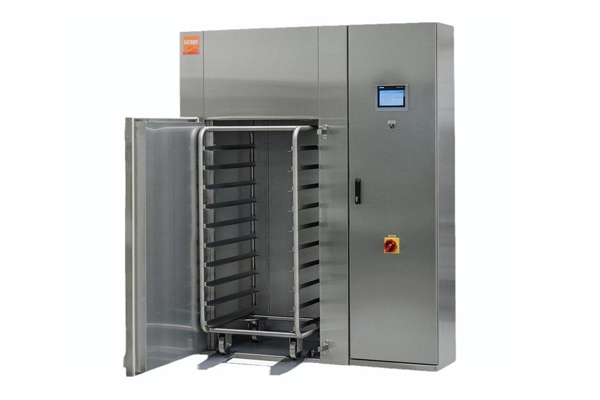MACHINE DESCRIPTION
- Fabricated in double walled construction S.S. 316 quality frame work from inside & outside the unit mounted on rigid S.S. 304 frame work, the gap in between the two walls is filled with thick fiber glass wool for insulations.
- The unit is also provided with air inlet, air filter, adjustable air outlet & insulated door etc.
- Unit is provided with a double door at the front side.
- The door will be locked with the help of I bolt Type.
- The door lips will have silicon gasket prevent the leakage.
WORKING PRINCIPLE
In small, dryers the material is placed on trays, which slide into the drying cabinet, while in large installations the interior may be designed for the wheeling in of trolleys containing the trays. The simplest form of heating places the sources of heat (e. g. a steam coil or electrical coil) at floor level and relies on natural convection. Fans provide a forced circulation of air across the trays. Air flows in axle direction over each shelf in turn. The wet material spread directly on the shallow trays resting on the shelves. Electrical elements (heater) or steam heated pipes are positioned so that air is periodically reheated after it has cooled by passage over the wet material on one shelf before it passes over the material on the next shelf. Tray dryer is a type of Fixed Bed Dryers i.e., the bed of the material to be dried is stationary.
AIR CIRCULATION
Air inside the dryer will be circulated by heavy duty axial flow fans fitted on shaft/s of suitable Dia. and driven by Non FLP motors of suitable H.P. with ISI mark through belt. The special design of the motor ensures uniform air circulation, so that there is uniform air current over the entire charge loaded inside the trolley, inside the dryer.
Uniform air circulation, controlled temperature, sturdy construction and large working space are the valuables of the dryer which is suitably designed to cover wide temperature range, loading and unloading is faster and simple. In higher capacities trays trolley rolls in and out of the chamber. For continuous operation a spare trolley can be had for loading while the drying cycle is taking place.
TEMPERATURE CONTROL
Temperature control system is done by electronic digital temp controller fitted in the control panel. The temperature control in the dryer is fully automatic.
NOTE : In steam heated model, digital temperature indicator is provided with digital timer, but the temperature controller is not supplied with the machine.
BLOWER
- The hot air is circulated in the drier by means of a fan fitted on the side of the oven and driven by a suitable HP motor.
- The hot air is passed through 5micron filter.
- The blower is capable to ensure uniform air circulation inside the drier and the same can be monitored by digital temperature indicator at two different places.
ELECTRIC HEATING
- Air is passed through totally enclosed electrical finned type strip heaters (Thermic fluid heating type) to obtain maximum temperature.
- The hot air is circulated in the drier by means of a fan fitted on the side of the oven and driven by a suitable HP standard motor.
- The hot air is passed through 5 micron filters. The blower is capable to ensure uniform air circulation inside the drier.
STEAM HEATING
- Air is passed through totally enclosed steam radiator with steam coils of finned type to obtain maximum temperature.
- Steam is controlled by solenoid valve.
- Heater assembly complete with all steam inlet connections like pressure reducing valve, solenoid valve, pressure gauge with syphon tube and pressure release valve as a separate fitting to the inlet connections. Steam outlet line will be complete with steam trap bucket type.
TRAYS
Trays are used to hold the material, allowing hot air to circulate through and evaporate moisture.
AIR CIRCULATION
A fan or blower circulates heated air through the chamber, promoting even drying
Heating System
Heaters (electric, steam, etc.) heat the air, which is then circulated through the trays.
Moisture Removal
Moist air is expelled from the chamber, while a portion may be recirculated to maintain temperature and humidity levels.
Control System
Controls allow for adjustment of temperature, airflow, and recirculation rates to optimize drying conditions.
